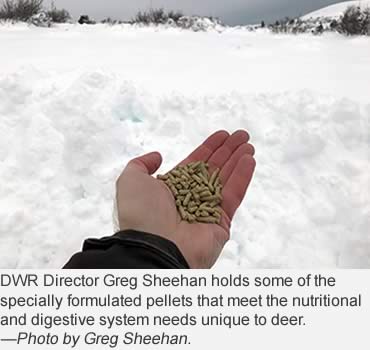It’s all about saving the deer.
That’s because more than 30 inches of snow and bitter cold temperatures are threatening deer survival in part of Utah’s Bear Lake Valley.
Fortunately for the deer, help is on its way.
This is the first time emergency deer feeding has been needed in Utah since 2008.
On Jan. 13, biologists with the Division of Wildlife Resources and hunters from sportsmen's groups teamed up to start an emergency deer feeding program in Garden City, located in the northeastern corner of the state.
According to Department of Wildlife Resources Director Greg Sheehan, biologists have been monitoring deer and winter range conditions across Utah closely this winter. He says the weather in the Bear Lake Valley is an anomaly compared to other locations in the state.
"Although weather has been severe across parts of Utah this winter," he says, "the Bear Lake area is the only location where emergency deer feeding needs to happen right now. We're prepared to feed deer in other locations, though, if the need arises.
"These deer are exhausted, confused and without options," Sheehan says. "They need help."
Both DWR biologists and hunters from conservation organizations are getting the deer the help they need.
 "One person in particular — Travis Hobbs — has been a tremendous help," Sheehan says. "Travis owns a construction business in Garden City. He's letting us store 12 tons of specially designed pellets in his warehouse. And he and his employees are donating their time and their heavy equipment to clear snow out of areas so we can spread pellets for the deer to eat. We simply couldn't do what we're doing without their help."
"One person in particular — Travis Hobbs — has been a tremendous help," Sheehan says. "Travis owns a construction business in Garden City. He's letting us store 12 tons of specially designed pellets in his warehouse. And he and his employees are donating their time and their heavy equipment to clear snow out of areas so we can spread pellets for the deer to eat. We simply couldn't do what we're doing without their help."
Sheehan says the DWR has many great conservation partners and volunteers. These groups and individuals have a long track record of helping wildlife.
"This case is no exception," he says. "Local volunteers — including members of the Mule Deer Foundation, Sportsmen for Fish & Wildlife and the Rocky Mountain Elk Foundation — have come to our aid."
Amidst the challenging news, Justin Dolling, Northern Region supervisor, says the good news is that deer in the Bear Lake Valley entered the winter in excellent physical condition.
"Even though the winter has been tough on them," he says, "their body condition is still good. Hopefully, the feeding program will help it stay that way."
Dolling says biologists are feeding the deer a specially formulated pellet that meets the unique nutritional needs and digestive systems deer have.
He says the pellet is the only item biologists will feed the deer. Alfalfa, grass hay or other products will not be used.
"This specially formulated pellet gives deer the correct balance of energy and protein the animals need," he says. "Products other than this pellet can actually hurt the deer. We appreciate the concern many folks have about deer in Utah this winter, but we strongly discourage people from feeding deer on their own."
Actively monitoring big game and their habitat in the winter is an important management function that helps protect Utah's deer herds.
The decision to feed deer in the Bear Lake Valley was made following guidelines in the DWR's Emergency Winter Big Game Feeding policy.
Across the West, mule deer numbers have declined, and many Utah hunters have found hunting difficult. The Division of Wildlife Resources not only takes hunters’ concerns seriously but is also wants to see deer-herd numbers improve.
Check out recent steps taken to safeguard the herd by click here.
— From the Utah Division of Wildlife Resources